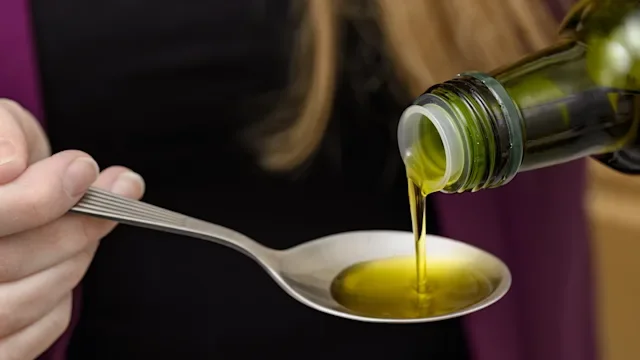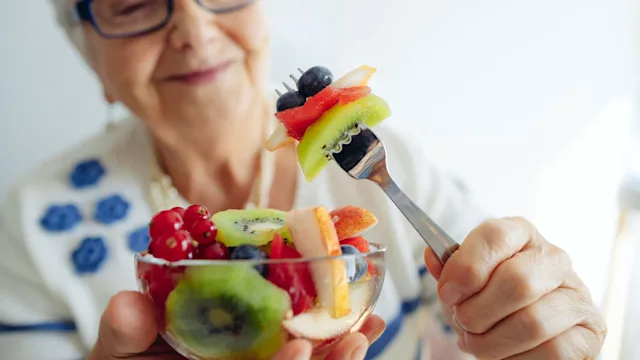Key takeaways:
Red Dye No. 40 is one of the most common artificial colorings used in processed foods, beverages, medications, and cosmetics in the U.S.
Over the years, research has raised multiple concerns about the food additive’s safety, such as hyperactivity in children and allergic reactions.
Right now, we don’t have enough research to know if Red No. 40 causes serious health risks. The FDA maintains that the food dye is safe in small amounts.
Think about some of your favorite snacks from childhood. Maybe your list of go-tos included colorful slushies and push-up pops. Or gummies, pudding cups, and fruit punch. There’s something that all of these seemingly different treats share in common: Many are made with artificial colors.
If you ever wondered why a cherry-flavored popsicle would temporarily stain your tongue red, while a real cherry wouldn’t even leave a trace, the answer is likely Red Dye No. 40.
What is Red Dye 40?
Red Dye No. 40 is an artificial color that’s added to processed foods, medications, and cosmetics. Red No. 40 is currently 1 of 9 color additives certified by the FDA. Three of these — Red No. 40, Yellow No. 5, and Yellow No. 6 — account for 90% of all food dyes used in the U.S. In fact, a 2016 study suggests Red No. 40 is the most commonly used artificial food coloring in grocery items geared toward kids.
Is Red 40 bad for you?
It’s not totally clear based on the current research. Some human studies show negative health effects, while others don’t. Or it’s hard to make definitive statements about the results based on the study’s design. To add to that, many studies are done on animals. So the results can’t be applied to humans directly.
But the Center for Science in the Public Interest reports that Red No. 40 does raise health concerns. Here’s what we know so far.
Hyperactivity
One of the most common causes of concern is Red No. 40’s potential association with hyperactivity in children. This led to a 2022 review by the California Office of Environmental Health Hazard Assessment to see if there was a link.
Researchers found that about a quarter of the studies they examined showed an association between Red No. 40 and hyperactivity. The researchers concluded that the FDA’s current standards for how much Red No. 40 is safe are based on outdated data and that the allowed amount is too high.
There’s no evidence supporting that Red No. 40 causes attention-deficit hyperactivity disorder (ADHD). It seems that the dye only affects children who are particularly sensitive to it, which is difficult to determine. But some caregivers and adults with ADHD choose to avoid Red Dye No. 40 to be safe.
Allergic reactions
Red No. 40 is among at least four food dyes (along with Blue No. 1, Yellow No. 5, and Yellow No. 6) that can cause allergic reactions. These reactions are rare. And, when they do occur, they’re usually mild. Anaphylaxis and other severe reactions are uncommon.
Not all food additives are harmful. But here are some food additives you should avoid.
Is European food healthier? We review U.S. food ingredients that are banned in Europe and other countries.
Red dye isn’t the only food dye linked to ADHD symptoms. Here’s which artificial colors received a warning from the FDA.
Bladder cancer
A 2012 review reported that Red Dye No. 40, Yellow No. 5, and Yellow No. 6 have all been found to be contaminated with carcinogens. Carcinogens are substances that may increase the risk of developing cancer. One of these carcinogens is benzidine, which has been linked to an increased risk of bladder cancer.
Whether or not the small amounts of Red No. 40 allowed in foods by the FDA definitely lead to bladder cancer is unclear. But advocates are pushing for the FDA to consider the link more closely in light of a recent ban on Red Dye No. 3.
In January 2025, the FDA banned Red No. 3 because of research linking it to thyroid cancer in rodents. The rodents were fed a very large amount of red dye, much more than a human would ever eat. And the way thyroid cancer develops in rats can’t happen in humans. But despite this, the FDA still banned Red No. 3 because of the Delaney Clause. The Delaney Clause states that additives can’t be used in foods if they’ve been linked to cancer in humans or animals.
Read more like this
Explore these related articles, suggested for readers like you.
Migraines
Some experts believe that Red No. 40 may trigger migraines or worsen headaches in people who are particularly sensitive to food additives. The effect is relatively uncommon. But for those who notice a pattern, reducing or avoiding Red No. 40 may help lessen headache frequency or severity. While not everyone will be affected, it’s one more reason you might want to limit foods and drinks containing this dye.
Foods that contain Red Dye 40
Many foods that are bright red contain Red Dye No. 40, including:
Breakfast cereals
Sodas and other soft drinks
Condiments (most ketchups don’t contain dye though)
Puddings
Dairy products like ice cream, sherbet, flavored milks, and frozen yogurt
Baked goods
Chocolate candy and confections
Fruit juices
Fruit gummy snacks
Sports drinks
Energy drinks
Jello
Chewing gum
Several over-the-counter (OTC) medications and vitamins also contain Red No. 40. But you can’t rely on a food’s color to know whether or not it contains Red No. 40. Not all food products that contain Red No. 40 are a shade of red. The only way to know for sure is to read the ingredients label.
What is Red 40 made from, and how is it regulated?
Color additives are primarily made from petroleum, or crude oil, a fossil fuel. Without getting too technical, scientists change the chemical structure of these raw materials to create a concentrated, water-soluble dye. Once the dyes are created, they’re “rigorously tested” to ensure that they don’t contain any traces of petroleum before they’re added to food products.
It’s the FDA’s job to ensure that color additives are used appropriately and safely.
Is Red Dye 40 banned?
In the U.S., Red No. 40 is still legal. But in April 2025, the FDA announced a plan to phase out petroleum-based synthetic dyes (including Red No. 40) by the end of 2026. It’s not a formal ban yet. Companies are being encouraged, not forced, to switch to safer, plant-based colorings.
Some states are moving faster:
Utah banned it in schools in 2024.
West Virginia banned it in school meals from 2025 and statewide in all foods, drinks, and medications from 2028.
Virginia and California will ban Red No. 40 in school meals starting in 2027.
While these are the only states with enacted bans, more than 30 others are considering similar laws.
Internationally, Red No. 40 is not banned outright in any country, but its use is regulated in several places. In the E.U. and the U.K., it’s permitted in food products but must include labeling that specifies the color. In Norway and Finland, stricter rules apply to food additives like Red No. 40, reflecting a more cautious approach to synthetic dyes.
What are some ways to avoid Red 40?
If you want to avoid Red No. 40 in your foods and other products, your best bet is to take a look at the ingredients label on food products. Keep in mind that the higher up the dye is on the ingredient list, the higher the concentration of it is found in the product.
Red No. 40 may be listed under several names, including:
Red 40
Red 40 Lake
Allura Red AC
FD&C Red No. 40
FD&C Red No. 40 Aluminum Lake
Allura Red AC
CI Food Red 17
CI 16035
INS No. 129
E129
Fancy red
If you want to make colorful, homemade cupcakes and icing, there are several ways you can spruce up your sweet creations without using traditional food dyes like Red No. 40. For example, pigment from fruits and vegetables, like grapes and beets, can yield a red color. Some gel food colorants are also made with natural ingredients, if you don’t want to worry about trying to create dye at home.
Frequently asked questions
Red No. 40 is still on store shelves because, at typical levels, it hasn’t been proven to cause serious harm. The evidence for Red No. 40 is less clear than for other food additives that have been linked to cancer in animal studies. The FDA is nudging companies toward plant-based alternatives, but there’s no official ban yet.
No, Red Dye No. 40 and Red Dye No. 3 are different chemical dyes:
Red Dye No. 3 (also called erythrosine) was banned in food in the U.S. because studies linked it to cancer in animals.
Red Dye No. 40 hasn’t shown the same level of risk.
Both are artificial red food colorings. But their safety profiles and regulatory status are different.
Yes, Red No. 40 isn’t just in foods. It can also appear in OTC medications, vitamins, and supplements. For most people, it’s safe at the levels used in these products.
However, if you’re particularly sensitive to food dyes, you may notice mild reactions, like headaches, hyperactivity, or skin irritation. Reading labels carefully can help you avoid it if needed. And consulting a healthcare professional is always a good idea if you have concerns.
Red No. 40 is still on store shelves because, at typical levels, it hasn’t been proven to cause serious harm. The evidence for Red No. 40 is less clear than for other food additives that have been linked to cancer in animal studies. The FDA is nudging companies toward plant-based alternatives, but there’s no official ban yet.
No, Red Dye No. 40 and Red Dye No. 3 are different chemical dyes:
Red Dye No. 3 (also called erythrosine) was banned in food in the U.S. because studies linked it to cancer in animals.
Red Dye No. 40 hasn’t shown the same level of risk.
Both are artificial red food colorings. But their safety profiles and regulatory status are different.
Yes, Red No. 40 isn’t just in foods. It can also appear in OTC medications, vitamins, and supplements. For most people, it’s safe at the levels used in these products.
However, if you’re particularly sensitive to food dyes, you may notice mild reactions, like headaches, hyperactivity, or skin irritation. Reading labels carefully can help you avoid it if needed. And consulting a healthcare professional is always a good idea if you have concerns.
The bottom line
The research is a bit inconclusive when it comes to whether or not Red Dye No. 40 can be harmful to human health. But many believe the risk outweighs any potential benefit. If you choose to avoid Red No. 40, make sure to check ingredient labels to see whether or not a food item contains it. Not all food items that contain Red No. 40 have a red color.

Why trust our experts?



References
Akgor, M. C., et al. (2023). Distinct food triggers for migraine, medication overuse headache and irritable bowel syndrome. Journal of Clinical Medicine.
Batada, A., et al. (2016). Prevalence of artificial food colors in grocery store products marketed to children. Clinical Pediatrics.
European Food Safety Authority. (2015). Refined exposure assessment for Allura Red AC (E 129). EFSA Journal.
Feketea, G., et al. (2017). Common food colorants and allergic reactions in children: Myth or reality? Food Chemistry.
Hofseth, L. J., et al. (2024). Allura Red AC is a xenobiotic. Is it also a carcinogen? Carcinogenesis.
Kobylewski, S., et al. (2010). Food dyes: A rainbow of risks. Center for Science in the Public Interest.
Kobylewski, S., et al. (2012). Toxicology of food dyes. International Journal of Occupational and Environmental Health.
Leasca, S. (2025). This is the first state to pass a sweeping ban on synthetic dyes and preservatives in a landmark move. Food & Wine.
Lehmkuhler, A. L., et al. (2020). Certified food dyes in over the counter medicines and supplements marketed for children and pregnant women. Food and Chemical Toxicology.
Miller, M. D., et al. (2022). Potential impacts of synthetic food dyes on activity and attention in children: A review of the human and animal evidence. Environmental Health.
Moniuszko, S. (2025). What artificial food dye bans mean for your health and fridge. CBS News.
National Cancer Institute. (2024). Benzidine.
Office of Environmental Health Hazard Assessment. (2021). Health effects assessment: Potential neurobehavioral effects of synthetic food dyes in children. California Environmental Protection Agency.
Sandor, J. (2025). Certain additives will soon be banned from school meals in Utah. Fox 13 News.
U.S. Food and Drug Administration. (2023). Color additives questions and answers for consumers.
U.S. Food and Drug Administration. (2025). Color additive petition from Center for Science in the Public Interest, et al.; Request to revoke color additive listing for use of FD&C Red No. 3 in food and ingested drugs.
U.S. Food and Drug Administration. (2025). FDA to revoke authorization for the use of Red No. 3 in food and ingested drugs.
U.S. Food and Drug Administration. (2025). HHS, FDA to phase out petroleum-based synthetic dyes in nation’s food supply.
WDBJ7 News. (2025). Youngkin signs legislation banning artificial food dyes from school lunches.

















